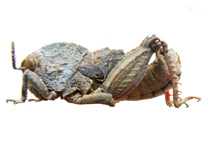Abstract
At least 95 species of Pamphagidae belonging to 17 genera are known in North Africa. Taxonomic status is fairly known, with some exception, mainly due to scarcity of available specimens of some genera in museums and collections. In this paper, the author proposes a new key to genera and reports the annotated list of all the known species, based on specimens examined in different European museums. Concerning the subfamily Thrinchinae, he proposes to consider only the following species of the genus Tmethis: T. cisti, T. harterti new status, T. maroccanus and T. pulchripennis. He also considers Neotmethis bidentatus synonym of T. harterti, and the three newly described species of the genus Tuarega as synonyms of T. insignis. In addition, he proposes to remove Batrachotettix elephas from the synonyms of T. insignis, because its description consents to establish that it belongs to a South African Porthetinae, not to a Thrinchinae. With regard to the subfamily Pamphaginae, the author recognizes the presence in North Africa of three tribes, until now containing 90 species: Finotiini, Pamphagini and Euryparyphini; Amigus is definitively considered a valid genus within the tribe Pamphagini, with the only species A. nigroadspersus. Additionally, he proposes a new key to species of the genus Paracinipe. He considers Paracinipe theryi as a valid species; previously it has been listed as subspecies of P. dolichocera. He also establishes that Acinipe calabra of Italy is the same taxon living in North Africa. Further, he describes Euryparyphes rungsi new species from Middle Atlas, and Paraeumigus lopezi new species from West Morocco, and synonymizes Eunapiodes granosus rungsi with E. atlantis. Finally, he reports biometric data of the genera Tmethis, Paracinipe, Paraeumigus and Eunapiodes.

